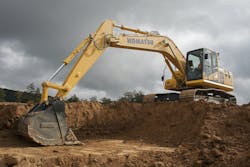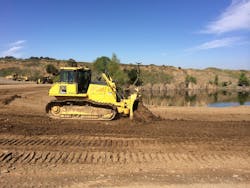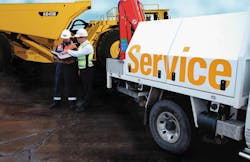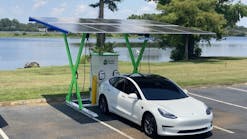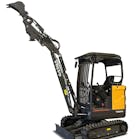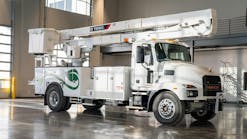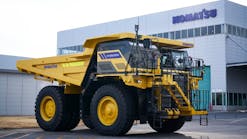Major construction equipment manufacturers such as Caterpillar, Volvo Construction Equipment, and John Deere Construction & Forestry have long used engine idle time as part of their pitches on telematics and fuel efficiency.
Komatsu was the first to make anti-idling a stand-alone, aggressive campaign, complete with training videos, signs, stickers and more. Its “No Idling” crusade is based on the tenet that idling is non-productive, making it more difficult to control owning and operating costs.
Idle time versus working time is one of the simpler data points to be gained from telematics.
“At a minimum, we’ll monitor monthly and focus on the areas that need the greatest attention, and then we’ll go in daily and just check on some of the units that have been idling excessively,” says Ned Boydell, equipment manager with Emil Anderson Construction (EAC), Kelowna, B.C., Canada, a heavy civil firm that has done major work in Western Canada and the U.S. “And you can do it from any remote location now—that’s the greatest advantage of telematics—and then we just send out violation notices.”
Before gaining telematics experience through Komatsu’s Komtrax system, measuring idling was tedious for EAC. “Other than physically observing excessive idling, we didn’t have any means of tracking idle times other than by the service meter reading as compared to what was being reported on the time cards for utilization,” Boydell says. “We didn’t know the magnitude of the excessive idle times because we didn’t have any good way of measuring it.”
In addition to excessive idling’s obvious negatives like wasted fuel, accelerated wear on components, and possible loss of DPF life because of additional soot, there are the more hidden, insidious losses like faster depreciation and expiration of warranty hours. These, too, add up.
“In purchasing new equipment, warranty costs are a major piece,” Boydell says. “Say on a $390,000[USD] unit, you’re probably looking at between $11,000 to $15,500 for a good warranty package, so you don’t want to burn that up just sitting idle.
“When you put hours on a machine that you’re actually not working it, it prematurely depreciates the value of the equipment, as well,” Boydell says. “If we’ve got an equipment fleet with a $32-million estimated replacement value and save just 1 or 2 percent there in depreciation cost by decreasing idle time by 10 or 15 percent, we probably save $388,000 annually, which is significant.”
Boydell has also found that an anti-idling policy for EAC’s 400 units of rolling stock helps in other areas. “With decreasing idle time and getting the machines shut off, we’ve found it encourages operators to get out of the cabs more frequently to do walk-arounds and visual inspections, which leads to big savings on your repair costs,” he says. “They’re more likely to catch minor issues before they become major failures.”
And there are other discoveries related to excessive idling. A quick look at telematics data can determine if an individual operator may be wasting time and precious fuel. That makes it a learning opportunity for the operator or it may tell a manager something else valuable—that the layout or procedure on a particular job is less than optimal. Where is the fill being placed? Is the haul road where it needs to be? Are loaders having to travel too far to meet trucks?
Whether operator related or job related, there may be a money-saving adjustment to be made.
In general, Komatsu recommends turning machines off at lunch and during breaks, avoiding idling for more than 5 minutes, and limiting cool-down periods to 3 minutes.
EAC has gone further, mandating no more than 3 minutes of idle time. “We were pushing 40 to 45 percent idle times on some machines, so when we started measuring, we thought 25 percent idle time is where we set the bar and, of course, go down from there,” Boydell says. “One of our policies is that if you have to sit idle more than 3 minutes, you shut the machine down.
“During very cold temperature warm-up periods, where you gauge the amount of time required for idling until the windows are clear of moisture and/or frost, you can idle the machine,” Boydell says. “But once you’re up to operating temperature and it’s safe to operate, you go to work—and then throughout the day no more than 3 minutes of idle time.”
EAC’s results have been impressive. “We’ve seen decreases in idle time down to as low as 10 percent now, so we’re very optimistic that we can average 15 percent idle time throughout the fleet, which would be a significant decrease over where we were two years ago,” Boydell says.
“On average we burn between 3 and 3.5 million liters of diesel annually, and you’re looking at 0.70[USD] a liter, so you’re talking about a lot of money,” Boydell says. “If you can even just save 2 to 3 percent on fuel alone, that’s a significant amount. Every once in awhile we see little spikes in idling, but we can address it immediately because we’re aware of it now with telematics.”
The contractor implemented its anti-idling policy from the top down, with a little help from the manufacturer’s “No Idling” materials. EAC also put decals on cab windows reminding operators of the 3-minute policy.
“The owners are on board with this. We started at the top and pushed the message down rather than starting at the bottom and going up,” Boydell says. “We got the greatest results that way, and the owners have also indicated that they’re going to put a bonus program in place so that if we can actually document our fuel savings by decreasing idle times, they’re willing to reward the people involved.”
Anti-idling posters adorn EAC’s project offices and key fobs put reminders squarely in operators’ hands.
“When we used to just talk to operators about idling, or initially when we were reading the telematics reports, we’d just send an email and say, ‘You’ve got to tell your operators to decrease idle times,’ and there wasn’t much of a buy-in,” Boydell says. “They were surprised. It was like they were in denial, but then the telematics gives you hard evidence to substantiate the fact they were idling, and those very operators were the ones who accomplished the most significant decrease.”
Boydell favors showing operators and job superintendents simple pie charts that compare working time versus idle time. “We can do a printout of the data we’re collecting, and visually, a pie chart really tells the story,” he says. “We can send those notifications right to the job site.”
Komatsu also offers some operating tips to go along with measurement and an anti-idling policy. First, simply work the machines—they’re built to work, not to sit and idle. And use economy mode whenever possible.
Machine engines, transmissions and hydraulics are more precisely matched than ever before, particularly in the Tier 4 era. Their control units sense how much power to pull during most tasks, so running full out isn’t always necessary for routine work in good soil. On tracked machines, reduce high-speed travel. Avoid operating machines in hydraulic relief, and do whatever is possible to eliminate wheel spin on wheeled machines.
Managers should continue to stress common sense operation, use telematics data, and develop an anti-idling policy to keep costs down.
“In today’s market, the profit margins are tight on projects and we have to remain competitive,” Boydell says. “One of the biggest commodities in any bid is fuel, so whatever we can do to save on fuel is significant to our success in securing work.”
